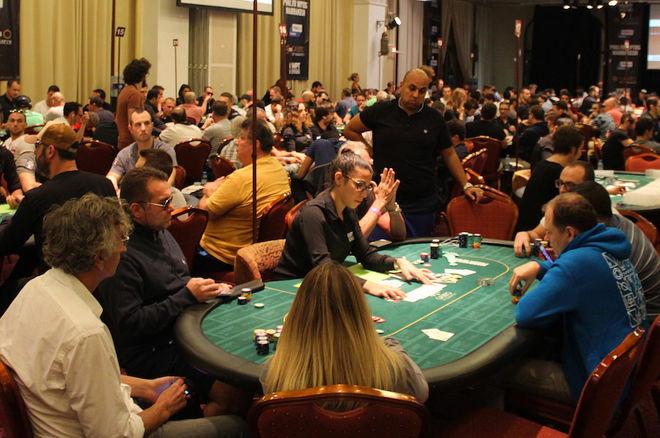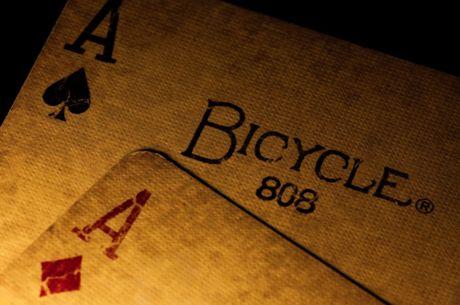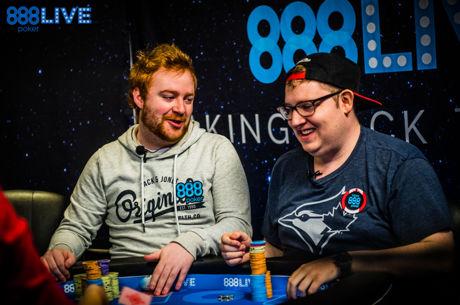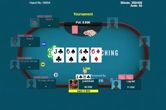Play Big to Win Big: Bet Sizing Against Obvious Drawing Hands

That phrase "play big to win big" comes from the title of an old gambling text, one written more than a half-century ago. The phrase actually alludes to a silly but oft-stated theory that a gambler should press his bets when he��s ahead, and contract them when he��s "running bad."
Such advice isn't worth a whole lot in most casino games like craps or roulette. But in no-limit or pot-limit poker, the size of your bets does matter, since bet sizing is inextricably linked to strategy. It��s important for the poker player not only to think about whether or not to bet, but how much to bet.
That much might be fairly obvious, even to the beginning player. But how do you decide whether to bet the minimum, all you have in front of you, or some amount in between?
There��s no simple answer, of course. One could write an entire book on the subject and still not cover every eventuality. But let me take a look at one aspect of this question about bet sizing and provide you with a counterweight to prevailing wisdom, if only to give you something to think about.
It all boils down to what you want to accomplish with your bet.
Let's say you��re in a juicy $1/2 NL game, one involving a number of opponents who are not very experienced. The general defect of your opponents is that they play too many hands preflop, then they stick with them for too long into the hand, often calling when they should be folding. Meanwhile you��re playing selectively and aggressively, making this an ideal game for you.
Now let's imagine a situation in which you are facing a decision on the turn, one in which you need to decide how much to bet with a hand you're certain is ahead of an opponent who is drawing to a flush.
You've been doing well, having roughly doubled up your starting stack to about $600. You are fortunate enough to be dealt A?A? in middle position, and after a couple of limpers you raise to $10. The button and the small blind call you, and the flop comes J?7?5?.
With a stack of about $400, the small blind checks, and you bet $20, earning a fold from the button. The small blind seems very indecisive before finally calling, then the turn brings the K?, making the board J?7?5?K?. The small blind checks again, and now you find yourself thinking about how much to bet.
Your first thought should be what you want to accomplish with your raise. Once you've determined that, your next thought should be determining what bet size will best achieve that objective.
Here your primary objective is to protect your hand. You��re in the lead, and you don��t want to be outdrawn. So you think that you should bet large to discourage your opponent from drawing. You think that to do that you need to bet big �� $100 or so �� to force the small blind off what you expected is his draw to a flush. In this way you would win the pot without risk that you would be outdrawn.
But then you remember someone somewhere encouraging players not to make huge bets designed to push opponents off drawing hands, but rather to seduce them into drawing with the wrong pot odds. The idea is that in the long run you��ll make more money by keeping your opponents in hands for the wrong price than by getting them to make correct folds by betting large amounts that they rightly refuse to call.
Aiming to bet an amount you think your opponent might incorrectly call, you choose to bet $30 and give him roughly 3-to-1 pot odds. In so doing, you encourage a call even though the price is a little too expensive to justify it since your opponent has drawing odds of a little more than 4-to-1 against him making his flush.
He calls the bet, and the river comes A?, making the final board J?7?5?K?A? and giving you a set. You figure you'll make another small bet of $30, just in case your opponent has a little something with which to call. He does call, showing K?9? for a pair of kings and busted flush draw. You win the pot and feel pretty damn good. Congrats.
But there��s another line that I want you to at least consider, one that flows from the fact that in many ��good�� games like the one described above, you have opponents who often make larger mistakes than do their better-skilled brethren.
What if your opponents include a few players who just cannot fold a flush draw, no matter what price they were paying to see the river? There are many such players out there in these low limit games �� I play against them all the time. What if the small blind was just such a player?
Against a player like that who might well call a very large bet, you should make a huge bet on the turn �� not because he��ll fold, but because he may well call it. This is especially true if, because of game conditions that may have arisen, he��s even more likely to make the call. Here are some possible reasons why making the huge bet might make sense:
- You have been dominating the table and might have an image as a bully �� or seem otherwise unlikable.
- Your opponent��s stack has diminished a lot lately and he may be psychologically defeated and ready to gamble it all on one last hand.
- Your opponent seems like the type who can��t resist drawing one more card.
- You have already successfully and demonstrably bluffed your opponent out of a hand.
- Your opponent made a similar call and won the hand by catching an opponent��s bluff.
- Your opponent is at heart a gambler and not a good poker player.
- Your opponent has been playing with reckless abandon and has been successful, so he thinks he��s ��running good."
Against players with the above-described characteristics a large turn bet makes sense. Realize that your overbet doesn��t have to be called every time to make money for you. If your opponent calls the overbet of $100, for example, a little more than one-third as often as he would call your $30 bet, you��d make more money than betting the more seductive $30 bet.
Of course many players, especially the more experienced ones, will rarely if ever call such a large bet when drawing, knowing the odds don't justify it.
Even so, against the typical less than savvy, low-stakes no-limit player, this huge bet �� or "playing big to win big" �� may show a profit.
Ashley Adams has been playing poker for 50 years and writing about it since 2000. He is the author of hundreds of articles and two books, Winning 7-Card Stud (Kensington 2003) and Winning No-Limit Hold'em (Lighthouse 2012). He is also the host of poker radio show House of Cards. See www.houseofcardsradio.com for broadcast times, stations, and podcasts.









